2 Financial stability outlook
2.1 Introduction
The financial sector consists of financial institutions, financial markets and financial infrastructure. It provides a wide range of products and services, including savings products, mortgages, damage and personal injury insurance, pension saving, payment services, and commercial loans. Well-functioning financial markets are a prerequisite for economic growth and contribute to individual economic security.
Financial stability implies that the financial system is sufficiently resilient to receive deposits and other repayable funds from the public, arrange financing, make payments and reallocate risk in a satisfactorily manner. This chapter shows that in 2015, financial institutions improved their ability to absorb losses without seriously weakening these important functions. Financial institutions also boosted their ability to function when access to new funding is reduced.
The financial stability outlook is affected by economic developments outside the financial sector. Losses among banks and other parties holding receivables from Norwegian households and businesses remained small in 2015. However, as the discussion of the macroeconomic picture, the market situation and risk developments shows, the risk of losses on loans to Norwegian households and businesses increased in 2015.
Textbox 2.1 Responsibility for financial stability
Responsibility for the safeguarding of financial stability in Norway is shared between the Ministry of Finance, Norges Bank (the central bank of Norway) and Finanstilsynet (the Financial Supervisory Authority of Norway. The Ministry of Finance has overarching responsibility for ensuring that the financial system functions well. Norges Bank and Finanstilsynet are tasked with promoting the robustness and efficiency of the financial system, and therefore with monitoring of financial institutions, securities markets and payment systems to identify stability threats. Moreover, Finanstilsynet supervises individual financial institutions and marketplaces. Norges Bank is the lender of last resort.
In 2006, so-called tripartite meetings were established between the Ministry of Finance, Norges Bank and Finanstilsynet. At these meetings, information is exchanged about Norwegian and international economic developments and the state of the financial markets. These meetings are held every six months, and more frequently when needed. Two such meetings were held in 2015.
2.2 The macroeconomic situation
The decline in oil prices since the summer of 2014 has reduced growth and increased unemployment in the Norwegian economy. Lower interest rates are helping to maintain consumption and investment growth, while a weakened Norwegian krone is fuelling production among businesses competing abroad. Fiscal policy is now having an expansionary effect on the economy.
Growth among Norway’s trading partners picked up slightly last year, driven by growth in the OECD countries. While the Eurozone recorded a modest increase, the Swedish economy grew strongly. The European Central Bank has ramped up its programme of expansionary measures. Sveriges Riksbank is also pursuing strongly expansionary monetary policy. In China, growth remains relatively high despite a slight slowdown, and the Chinese authorities are implementing expansionary budgetary and monetary policies. Russia and Brazil have been hit hard by low commodity prices. There is considerable uncertainty about future developments in China and other emerging economies. The situation in the Middle East, refugee flows to Europe and the United Kingdom’s referendum on EU membership also contribute to uncertainty.
Uncertainty about economic developments has fuelled market turbulence. International stock market indices recovered somewhat during the second half of February and March, after strong falls at the beginning of 2016. Several emerging economies have experienced capital outflows and sharp currency devaluations. Turbulence in international financial markets may undermine real economic growth going forward.
The weakening of the Norwegian krone and more moderate wage growth has improved competitiveness among Norwegian businesses. Some companies are reporting higher earnings due to the krone’s depreciation. However, it may take time for improved profitability to raise activity levels, partly because firms are uncertain about future developments and partly because some businesses have hedged against large movements in the krone exchange rate. The volume of exports from the mainland economy has risen despite falling demand from the international petroleum industry. Increased competitiveness has also helped Norwegian exporters win many of the contracts linked to the development of the Johan Sverdrup oil field.
Although consumers became more pessimistic in their assessments of the economic outlook in 2015, household demand for goods and services continues to grow at a moderate pace.
While house price inflation has slowed somewhat, there are substantial geographical differences. For example, house prices rose by 8 percent in Oslo over the past year but fell by close to 5 percent in Rogaland.
Although the rise in registered unemployment declined in the first quarter, LFS unemployment has risen markedly so far this year. The difference between the two figures has also increased as a result. The rise in LFS unemployment in the first quarter is linked to an increase in the number of young job seekers. Since they are not entitled to unemployment benefits, they probably do not register as unemployed with the Norwegian Labour and Welfare Administration (NAV). Figures provided by NAV show that unemployment has primarily risen in counties with strong ties to the oil industry.
In the National Budget 2016, the Ministry of Finance forecast growth in mainland Norway GDP of 1.8 percent this year. Oil price developments have been significantly weaker than anticipated. This indicates that growth in the Norwegian economy may be less than forecast in the budget published last autumn. The Ministry of Finance will present new estimates in the revised national budget in May.
2.3 Financial stability outlook
In 2015, the fall in oil prices and low interest rates were two main trends which potentially could affect financial stability in Norway.
Oil-related businesses account for a considerable proportion of the Norwegian economy.1 The central role of the oil industry in the Norwegian economy means that falling oil prices may threaten financial stability. The fall in oil prices may impact financial stability both directly – when banks have to accept losses on loans to the oil industry – and indirectly in the form of weakened growth prospects for the Norwegian economy. Bank exposure to the oil sector is discussed in section 2.3.1. The drop in oil prices is also affecting activity levels in the Norwegian securities market, where the high-yield bond segment is dominated by companies with direct or indirect links to the oil sector; see section 2.3.6.
Internationally, interest rates have fallen since the financial crisis, and are now at record lows both in nominal and real terms. Key policy rates are close to zero in many countries, and in some cases negative; see Box 2.2. The experience of Norway and other countries thus far is that cutting the interest rate level helps reduce losses and defaults in bank lending portfolios, and that low interest rates boost demand for credit from banks without weakening banks’ interest rate margins. Experience also shows that low interest rates may encourage excessive borrowing by households and businesses. To date, there are few signs that Norwegian businesses in general have reduced their capital ratios, despite low borrowing rates in recent years. However, highly indebted Norwegian households are vulnerable to economic shocks such as falling oil prices and rising unemployment. Issues relating to debt growth in Norway are discussed in section 2.3.3.
Pension funds and life insurance companies have generally refocused their sales and marketing in recent years, focusing on products and services which assign market risk to the insured parties. This transition began after the adoption of the Defined Contribution Pension Schemes Act in 2000. See also the discussion in section 2.3.5.
2.3.1 Bank exposure to the oil sector
Lower oil prices mean lower petroleum industry earnings. Lower earnings reduce the debt-servicing capacity of companies in the industry, in turn potentially requiring banks to accept larger losses on loans to the oil industry and oil-related sectors. The largest Norwegian banks are the primary lenders to the oil industry and oil-related sectors. In January 2015, Finanstilsynet gathered information on the credit exposures of the seven largest Norwegian banks to the oil industry and oil-related sectors and companies. The banks themselves estimated that lower oil prices would have a direct negative impact on between 5 and 25 percent of the individual banks’ aggregate business-market portfolios. Four of the banks also specified their credit exposure to companies which are indirectly affected by oil prices. Among these banks, the proportion varied from 4 to 12 percent.2
A sensitivity analysis conducted by Finanstilsynet shows that, in an extreme but not unrealistic situation, several of the Norwegian banks with the highest oil exposures may achieve only a break-even pre-tax result due solely to loan losses on oil and oil-related exposures.3 The analysis shows that the banks with the greatest oil-sector exposures are most vulnerable to drops in oil prices. Since fewer projects are profitable when oil prices are depressed, such drops cause oil industry actors to cut investment. A decline in oil-related investments also increases the risk of losses on loans to companies which are less directly affected by oil prices, such as commercial real estate companies and consultancy firms. In 2015, bank losses remained small, even in the counties with the highest rates of oil-industry employment. However, credit risk has increased, and banks must also be prepared for increased losses on loans to companies less directly impacted by oil prices if low oil prices weaken longer-term growth in the Norwegian economy.
As part of its Financial Sector Assessment Program (FSAP), the IMF has analysed links and ripple effects between different sectors in the Norwegian economy.4 In particular, the IMF examined the impact of other industries on the development of the financial industry. The results of the IMF analysis indicate that approximately 30 percent of bank results can be explained by developments in oil-related activities and the effect of such activities on other mainland industries. This proportion is higher than indicated, in isolation, by the share of total lending accounted for by bank loans to the oil sector. The IMF analysis also shows that the outlook for the real estate sector depends on oil industry developments.
2.3.2 Improved bank solvency
The years after the financial crisis have been a period of prolonged strong development of the Norwegian economy. The economic growth has been a boon to Norwegian banks as it has contributed to low losses, high demand from borrowers, and easy access to financing. This has allowed banks to deliver strong results for several years. In 2015, banks achieved a pre-tax profit of more than NOK 57 billion – the highest ever annual profit and around 6 percent higher than in 2014. However, profits as a proportion of average capital under management dropped slightly, to 1.1 percent. The return on equity (calculated as the post-tax profit/loss relative to equity), was 12.2 percent in 2015, 0.6 percentage points lower than in the previous year; see Figure 2.2.
Net interest income, i.e. the difference between interest income and interest costs, accounts for approximately three-quarters of Norwegian banks’ total revenues. The interest rates charged by banks on their loans have fallen in recent years, see Figure 2.6, although cheaper bank financing in the securities markets has helped reduce interest costs. A contributory factor is that creditor risk has declined, not least as a result of higher equity holdings among banks. Higher equity levels also help reduce the need for banks to debt finance their lending activities.
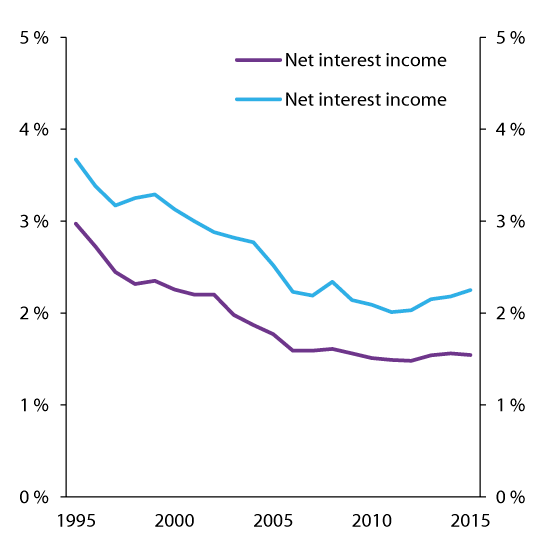
Figure 2.1 Net interest income as a proportion of average capital under management and interest rate margin. Percent
Source Finanstilsynet
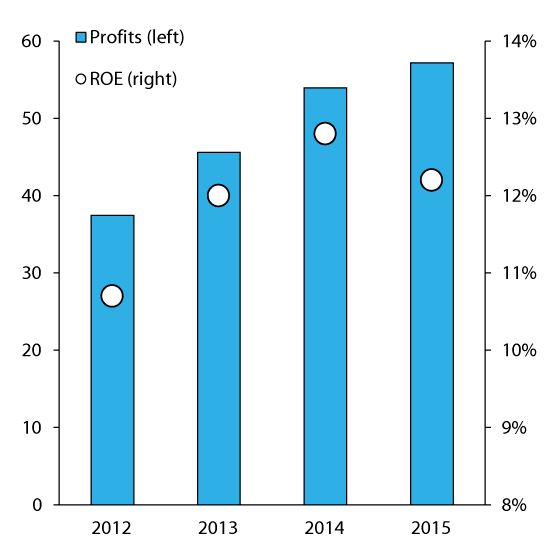
Figure 2.2 Profits of Norwegian banks in NOK billion (left axis) and return on equity (right axis)
Source Finanstilsynet
Textbox 2.2 Negative interest rates
After the financial crisis, key policy rates have reached very low levels, in many cases approaching zero. Four European central banks have introduced negative key policy rates since mid-2014. The primary motivations behind negative key policy rates have been to counter weak inflation (in the Eurozone and Sweden) and to depreciate a strong currency (in Switzerland and Denmark).
Economic literature has often assumed that the nominal interest rate level cannot fall (significantly) below zero because it will always be possible to achieve a nominal interest rate level of zero by holding cash. In reality, however, holding cash gives rise to costs (e.g. security measures, transportation and insurance), and the effective lower bound therefore lies somewhat below zero. Countries with negative key policy rates have found that the money markets mostly track falling key policy rates. However, the deposit rates offered to customers by banks appear to correlate less closely, and demand for bank deposits has thus not dropped off markedly.
Negative interest rates have also presented practical challenges, including clarification of tax questions (Denmark), adjustment of settlement systems (Sweden) and changes in the contract terms of residential mortgages indexed to the key policy rate (Switzerland).
The need for monetary policy measures following the financial crisis has renewed interest in how the interest rate level and the shape of the yield curve, respectively, affect bank profits. On the one hand, low interest rates reduce defaults in the short term and increase securities gains, which in turn boost bank profits. Nonetheless, an empirical study by the Bank for International Settlements (BIS) indicates that the positive contributions are insufficient to counter a reduction in banks’ net interest income.5 In the case of banks, which convert liquid or short-term deposits into long-term loans (so-called maturity transformation), a flatter yield curve will, all other things being equal, also reduce net interest income. Moreover, a flatter yield curve and low interest rates may arise simultaneously, as at present in many European countries. The Bank for International Settlements finds that the links between the interest rate level and bank earnings are not linear, and that the negative effect on bank interest income is stronger as the yield curve flattens or the interest rate level approaches zero; see Box 2.2.
Strong profits and moderate dividends have allowed Norwegian banks to improve their solvency in recent years by retaining profits. Their improved solvency means that Norwegian banks are now better equipped to absorb losses.
Only capital capable of protecting ordinary customers against losses may be approved as regulatory capital. However, regulatory capital consists of elements of differing quality (loss-absorption capacity). CET1 capital is the highest-quality part of the total capital, and is used first to cover any losses. CET1 capital largely comprises bank equity. The remainder of the total capital consists of tier 2 capital and other instruments which share characteristics with both debt and equity, and can only be used to cover losses if the CET 1 capital is lost.
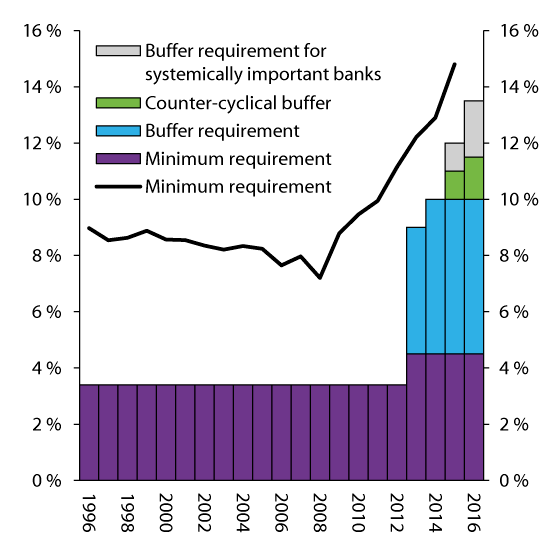
Figure 2.3 CET1 capital as a percentage of risk-weighted assets for Norwegian banks and banking groups, and CET 1 capital adequacy minimum and buffer requirements
Source Finanstilsynet and the Ministry of Finance
Textbox 2.3 Losses and default
Loan losses were 4 percent higher in 2015 than in 2014, and amounted to 0.17 percent of the total lending balance. Losses amounted to 10 percent of banks’ pre-loss profits, or 1.7 percent of their equity. The volume of defaulted loans was reduced by 5 percent in 2015, although it increased slightly in the fourth quarter. Defaulted loans accounted for 1.1 percent of total bank loans at the end of 2015, representing a drop of 0.2 percentage points from 2014; see Figure 2.4.1
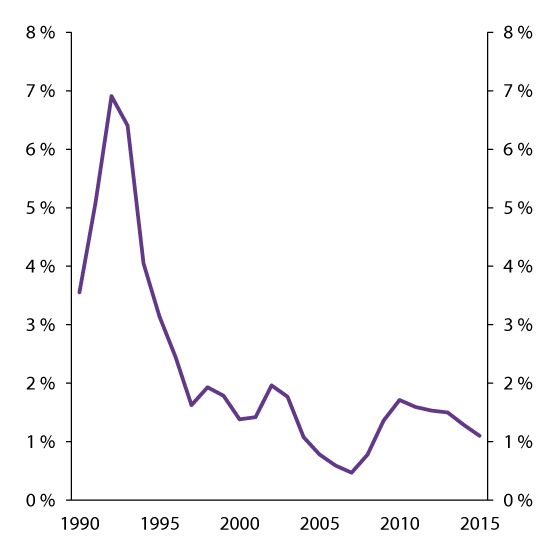
Figure 2.4 Defaults on loans from Norwegian banks. Percent of lending volume
Source Finanstilsynet
1 Classified as being in default no later than 30 days after the due date/date of overdrawing.
Banks with substantial CET 1 capital have a lower risk of suffering financial difficulties due to losses. Such banks also present a lower risk of pre-empting potential problems by tightening lending practices during an economic downturn. The level of CET 1 capital is thus more important for the stability of the economy and the banking system than the level of other total regulatory capital. A particular stabilising factor is that systemically important banks have a strong ability to continue operating after making losses. If such a bank tightens its lending practices during a downturn, this alone may impact the economy in terms of accelerating and deepening the downturn. Solvent banks stabilise both one another and the economy during a downturn.
CET1 capital adequacy expresses a bank’s CET 1 capital as a percentage of risk-weighted assets, and is the most important indicator for measuring and comparing the solvency of banks internationally and in Norway. Risk-weighting entails adjusting the value of an asset, such as a loan, based on the likelihood and size of the potential loss. CET 1 capital adequacy thus provides a figure designed to reflect loss-absorption capacity. However, this figure greatly simplifies complicated interconnections, and may also be misleading if, for example, the risk weights are too low relative to real risk. Different risk-weighting of the assets of different banks may also produce considerable differences in CET 1 capital adequacy, without the banks necessarily having different risk levels.
Another key solvency indicator is the leverage ratio, i.e. a bank’s tier 1 capital as a percentage of a non-weighted exposure measure (total assets and non-balance sheet items). There is some concern that risk weights internationally have fallen too low, and plans have therefore been made to introduce a leverage ratio requirement to prevent the absolute volume of loss-absorption capital from becoming too small; see further discussion in section 3.3.5.
Textbox 2.4 Counter-cyclical capital buffer requirement
The counter-cyclical capital buffer requirement is an element of the new capital requirements legislation introduced in Norway in 2013, which are based on the EU’s new capital requirements rules (the CRR/CRD IV framework). The level of the counter-cyclical requirement is to be adjusted in view of developments in the Norwegian economy, and is set to ensure that banks reinforce their solvency in periods of economic growth. The requirement will vary between 0 and 2.5 percent of risk weighted assets. The purpose of the counter-cyclical capital buffer is to improve the capacity of banks to absorb loan losses during a future downturn and reduce the risk of banks amplifying an economic downturn through more restrictive lending practices. The counter-cyclical buffer requirement is a tool which shall be applied during periods of particularly high credit growth or other developments which increase cyclical systemic risk. If economic activity declines, the requirement may be lowered or reduced to zero. Whereas an increase in the counter-cyclical buffer requirement normally has to be notified at least 12 months in advance, a reduction can be implemented immediately.
The Ministry of Finance sets the level of the counter-cyclical capital buffer every quarter. Norges Bank is mandated to provide supporting data and advise the Ministry on the appropriate level. The bank does this through both its monetary policy reports and separate letters of advice to the Ministry.
In December 2013, the Ministry of Finance decided that banks must meet a counter-cyclical capital buffer requirement of 1 percent of risk weighted assets as from 30 June 2015. The decision remained in force throughout 2014. In June 2015, in line with advice from Norges Bank, the Ministry decided that the counter-cyclical capital buffer requirement should be increased to 1.5 percent with effect from 30 June 2016.
Textbox 2.5 Systemically important financial institutions
To reduce the likelihood of individual institutions experiencing financial problems with serious negative consequences for the financial system and the real economy, section 14-3 of the Financial Undertakings Act requires systemically important financial institutions to maintain a CET 1 capital buffer totalling 2 percentage points in addition to the minimum CET 1 capital requirement, the capital conservation buffer and the systemic risk buffer.
Every year, the Ministry of Finance is required to decide which financial institutions are of systemic importance in Norway. The Ministry identified DNB ASA, Nordea Bank Norge ASA and Kommunalbanken AS as systemically important financial institutions in May 2014, and reaffirmed their status in June 2015.
The average risk-weighted CET 1 capital adequacy ratio of Norwegian banks was 14.7 percent at the end of 2015; see Figure 2.3, representing an increase of 1.8 percentage points from 2014. The CET 1 capital adequacy ratio for banks as a whole has risen steadily since 2008, by a total of 7.6 percentage points. The increase in the CET 1 capital adequacy ratios of Norwegian banks following the international financial crisis indicates that Norwegian banks are now significantly better equipped to deal with a downturn in the Norwegian economy. The increase in the CET 1 capital adequacy ratio reflects stricter requirements, and all Norwegian banks met the current minimum requirements and buffer requirements at the end of 2015. The leverage ratio of Norwegian banks totalled 7.1 percent at the end of 2015. The difference between the (risk-weighted) CET 1 capital adequacy ratio and the leverage ratio has been increasing for several years.
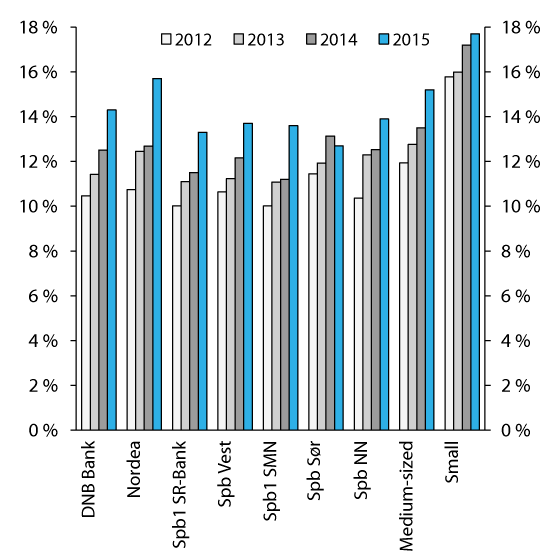
Figure 2.5 CET1 capital of Norwegian banks.1 Percent of risk weighted assets
1 Medium-sized banks are defined as banks with more than NOK 10 billion in capital under management. Small banks are banks with less than NOK 10 billion in capital under management.
Source Finanstilsynet
2.3.3 Debt
2.3.3.1 Household debt growth
Loans from financial institutions represent debt in other sectors. Loans to households account for more than half of the total lending balance of Norwegian banks and mortgage companies, and over 90 percent of household debt consists of residential mortgages. Norwegian banks’ credit risk is therefore closely linked with the ability of Norwegian households to pay interest and instalments on their residential mortgages. The actions of households also impact indirectly on bank credit risk, for example through bank loans to businesses vulnerable to changes in household consumption.
The debt burden and the interest burden are indicators of the ability of households to service debt. The interest burden is interest expenditure as a percentage of disposable income. Due to low residential mortgage rates in recent years, the interest burden of Norwegian households has not been particularly high; see Figure 2.7. Average residential mortgage interest rates fell by 0.9 percentage points in 2015; see Figure 2.6. Interest rates are expected to remain low in the near future.
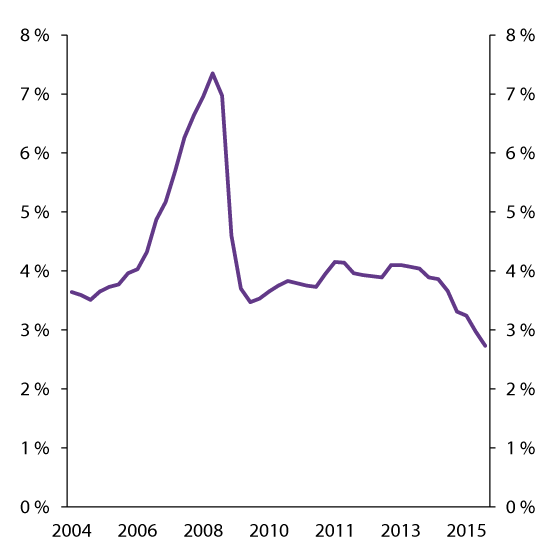
Figure 2.6 Interest rate on residential mortgages issued to private customers. Weighted average of all banks in Norway, including mortgage companies that can issue covered bonds. Percent
Source Finanstilsynet
Low interest rates stimulate demand for loans, and Norwegian households’ debt growth has outpaced their income growth among for several years, increasing the debt burden. According to Norges Bank, the debt burden (gross debts as a percentage of disposable income) now exceeds 215 percent – a high level both from a historical perspective and compared with other countries. Household indebtedness has been identified as one of the primary vulnerabilities of the Norwegian financial system not only by national authorities such as Finanstilsynet and Norges Bank, but also by international organisations like the IMF and OECD.
High debt levels increase the vulnerability of households in the event of adverse economic developments such as falling housing prices, and thus increase the likelihood of a subsequent cut in consumption. Debt growth more in line with household income growth may therefore promote a more stable growth in demand for goods and services. With the aim of more sustainable housing price and household debt growth, the Ministry of Finance adopted regulations on new residential mortgages on 15 June 2015; see section 4.1.2. There are signs of a slowdown in household credit growth. In February 2016, the annualized growth rate was 6.0 percent. Nevertheless, debt growth remains higher than income growth, and there is considerable uncertainty about future developments.
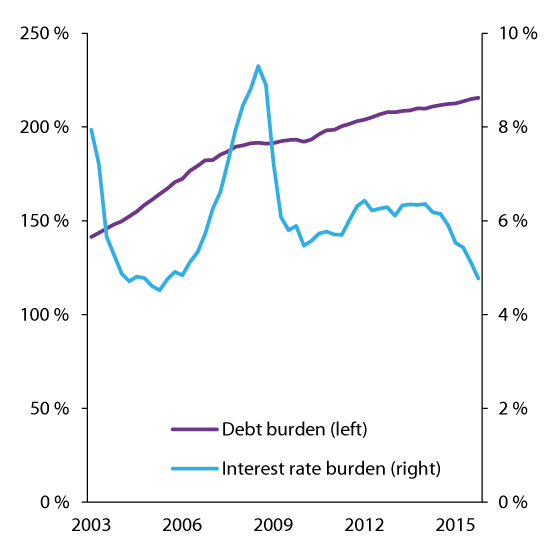
Figure 2.7 Household debt burden (left axis) and interest rate burden (right axis). Percent
Source Statistics Norway and Norges Bank
The proportion of households with debts exceeding five times disposable income has increased since the late 1990s; see Figure 2.8. These highly indebted households also hold an increasing share of total debt. However, this group comprises primarily younger households and households with medium to high incomes. Although a high debt burden renders households more vulnerable, it should generally be easier to handle for households with high incomes or expected income growth.
Thorough credit assessment and correct loan pricing may restrain households from amassing more debt than they are able to service, and may therefore also assist in limiting the development of debt problems among households. Lenders require information about matters such as a borrower’s total debt burden in order to run an optimal assessment process. A register of personal debt, available to lenders in the credit assessment process, could be a useful tool for providing such information. One measure proposed in the Government’s strategy for the housing market, presented in the spring of 2015, was to permit the creation of such a debt register by private actors.
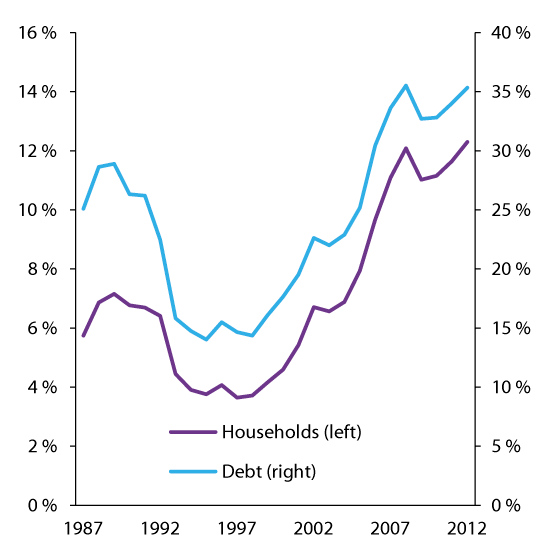
Figure 2.8 Households with debts exceeding five times disposable income. Proportion of households and debt
Source Statistics Norway and Norges Bank
Textbox 2.6 Consumer loans
Various financial institutions and some banks engage in consumer financing. Consumer loans are generally unsecured and entail high credit risk. Strong profitability has attracted new providers to the consumer loans market, and the growth in such loans has outpaced general household credit growth.
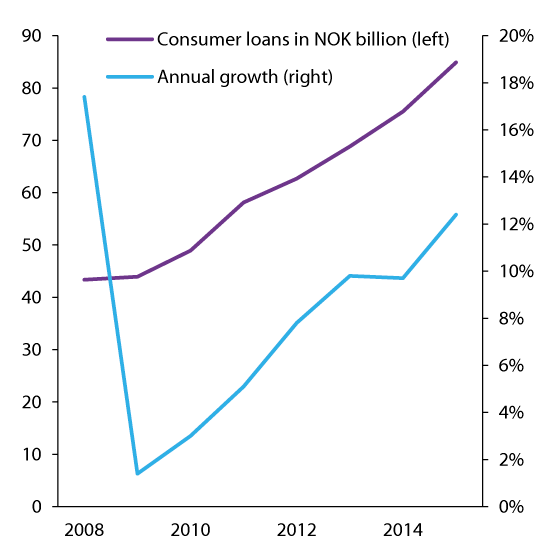
Figure 2.9 Consumer loans in NOK billion and annual growth in percent, selected banks and financial institutions
Source Finanstilsynet
Household borrowing for consumption purposes accounts for a small, but increasing, proportion of total household debt. Demand for such loans has risen significantly in recent years; see Figure 2.9. Unsecured consumer loans accounted for approximately 3 percent of total household debt at the end of 2015. The annual consumer-lending growth rate of selected1 banks and financial institutions was 12.4 percent at year-end 2015, up from 9.7 percent the previous year.
Losses on consumer loans were low in 2015, at 0.2 percent of lending volume, down from 1.3 percent in 2014; see Figure 2.10. The level of losses was on a par with the previous year (when adjusted for recognition of previous losses). However, the gross default rate on consumer loans increased from 4.5 percent at the end of 2014 to 5.3 percent at year-end 2015.
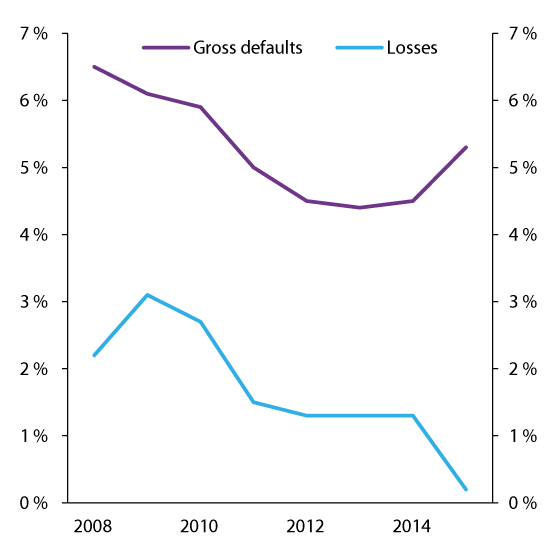
Figure 2.10 Gross defaults (90 days) as a percentage of consumer loans and loan losses as a percentage of lending volume
Source Finanstilsynet
1 The selected companies cover the majority of the market. The sample comprised 22 companies at the end of 2015 (12 banks and 10 finance companies). It includes both Norwegian companies and Norwegian branches of foreign entities.
The risk of financial imbalances developing in households is particularly acute during a prolonged upturn or – as in recent years – when interest rates remain low and demand for loans remains high for a long period of time. If banks’ lending practices are imprudent during such periods of high loan demand, major imbalances may develop in an economy. Finanstilsynet reviews banks’ mortgage lending practices annually. The most recent residential mortgage survey, from the autumn of 2015, shows that banks have tightened lending practices somewhat but continue to grant a significant number of loans resulting in high borrower indebtedness; see Box 2.7.
Textbox 2.7 Finanstilsynet’s residential mortgage survey
Finanstilsynet reviews banks’ issuance of residential mortgages every year. The most recent residential mortgage survey was conducted in the autumn of 2015. Among loans included in the survey, 30 percent related to housing purchases. Some 6 percent of these loans were used to buy a second home. The proportion of loans used for second-home purchases has remained unchanged since 2012. The remaining loans were linked to the refinancing of an existing mortgage from the same bank (60 percent) or another bank (10 percent).
The survey findings include that around 16 percent of new residential mortgages had an loan-to-value (LTV) ratio of more than 85 percent – a drop of 3 percentage points from the previous year; see Figure 2.11. Accounting for additional collateral, 7 percent of loans had an LTV ratio exceeding 85 percent. The average LTV ratio rose from 65 percent in 2014 to 68 percent in 2015. For loans used for house purchases, the average LTV ratio was 76 percent. Some 28 percent of loans used for housing purchases had an LTV ratio above 85 percent, while 12 percent had an LTV ratio exceeding 100 percent. When additional collateral is included, these figures drop to 13 percent and 1 percent respectively.
Banks had obtained additional collateral for about two-thirds of amortising loans with a LTV ratio above 85 percent – an increase of approximately 10 percentage points compared to the period 2012–2014.
Average indebtedness, measured as total debt relative to gross income, was 297 percent among borrowers taking up amortising loans secured by residential mortgage. This represents a drop of 8 percentage points from 2014. Average indebtedness among young borrowers under the age of 35 was 341 percent, a drop of 15 percentage points compared to the previous year.
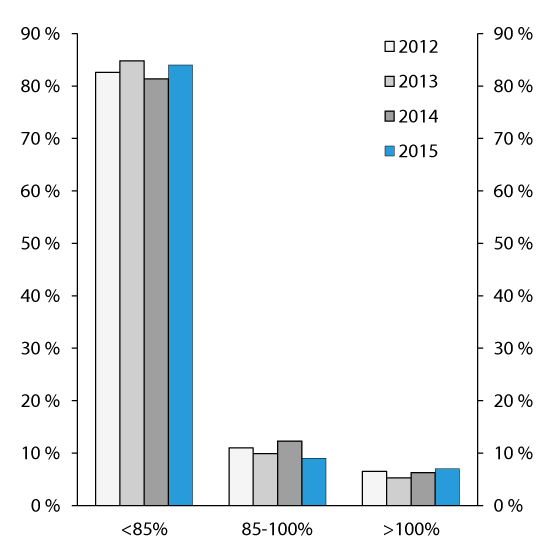
Figure 2.11 Distribution of loans by LTV ratio. Residential mortgage survey
Source Finanstilsynet
Textbox 2.8 Housing market developments
As an annual average, housing prices increased by 7.2 percent in nominal terms in 2015. Corrected for consumer price inflation, the increase was around 5 percent, clearly stronger than in 2014, when housing prices rose by 0.3 percent in real terms. House price inflation has slowed over the past half-year, presumably due to lower growth and higher unemployment in the Norwegian economy.
The high level of housing prices in Norway is linked to a preceding period of high income growth, strong population growth and low interest rates. Easy access to bank credit has also pushed up prices. Expectations of continued price inflation may also have contributed. In addition, factors such as a shortage of building plots, higher wage costs, stricter design requirements for new-builds and lower productivity in the construction industry have inflated building costs. Some of the cost increase has been rolled over into housing prices.
Increased urbanisation and differences in activity levels and income development have contributed to regional differences in housing price developments. Lower petroleum industry activity has resulted in rising unemployment in southern and western Norway. As a result, housing price growth has been significantly weaker in Stavanger than in other major cities over the past year; see Figure 2.12. Whereas housing prices in Oslo rose by 8.1 percent from February last year to February this year, in Stavanger they fell by 7.4 percent during the same period.
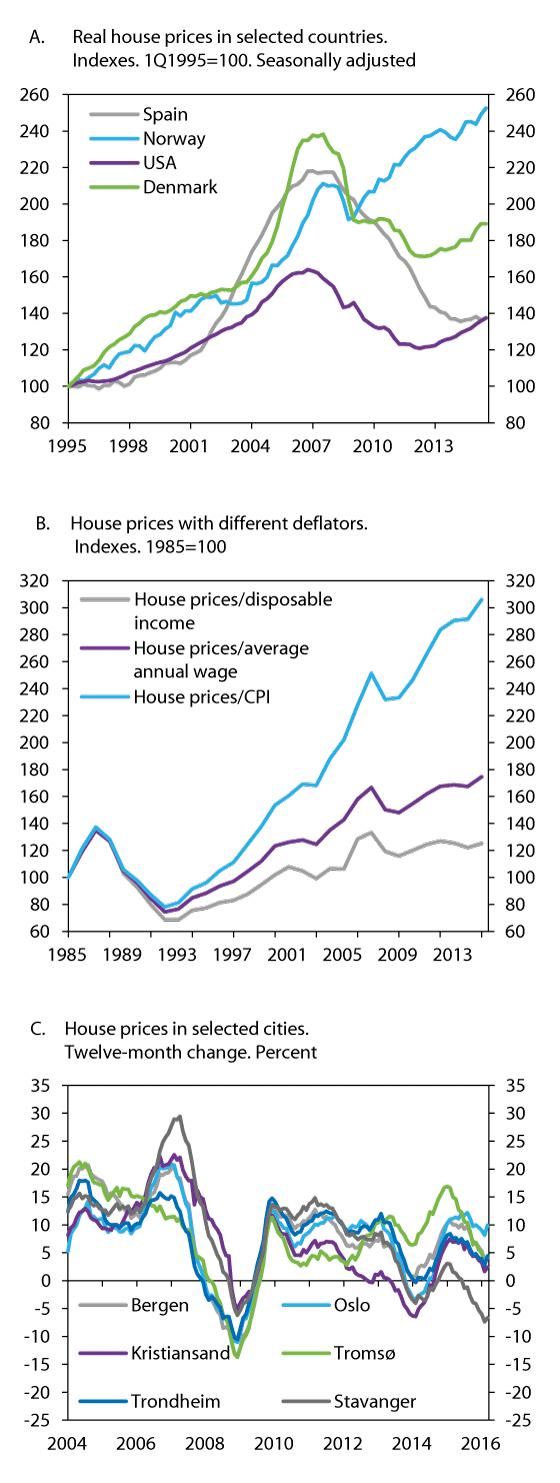
Figure 2.12 Housing price developments
Source Real Estate Norway, Finn, Eiendomsverdi AS, Statistics Norway, Macrobond and Ministry of Finance
2.3.3.2 Corporate debt
Around 30 percent of bank loans in Norway are made to commercial parties. The debt-servicing capacity of Norwegian businesses is therefore an important indicator of banks’ credit risk.
The growth rate of bank lending in the domestic business market was 5.6 percent at the end of 2015, although the rate declined towards the end of the year, sinking by 2.3 percentage points in the fourth quarter. In Norges Bank’s fourth-quarter lending survey, banks reported somewhat stricter corporate credit practice, including in relation to loans for the purchase of commercial real estate. Corporate debt growth has generally been lower after the financial crisis than in the years leading up to the crisis. Corporate debt and corporate investment are more closely linked to the economic cycle than the debts and investments of households, and in a downturn banks typically tighten credit standards for businesses. Corporate debt growth is therefore more volatile than household debt growth. However, volatility has decreased since the financial crisis.
Bank margins on commercial loans – measured as the difference between the lending rate and the three-month effective Nibor rate – have fallen in the past two years. Together with the declining interest rate level, this has lowered corporate lending interest rates; see Figure 2.13. The premium on bonds with a five-year maturity issued by low-risk industrial enterprises fell throughout 2014 before stabilising at a low level in the first half of 2015. The premium rose from around 60 basis points above three-month Nibor in the summer of 2015 to approximately 140 basis points by the end of the year.
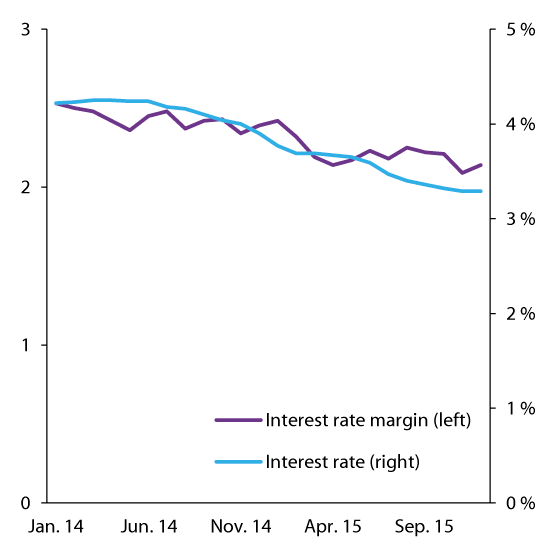
Figure 2.13 Margin on corporate loans in percentage points (left axis) and interest rate (right axis). Outstanding loans
Source Norges Bank
Loans from credit institutions make up the majority of domestic corporate debt; see Figure 2.14. Norwegian corporate debt growth in Norway and abroad are highly correlated, indicating that corporate borrowing abroad is generally not the result of low supply in Norway, and vice versa. A lower share of foreign borrowing is taking the form of traditional loans from credit institutions; see Figure 2.15, which shows the distribution of total corporate debt at the end of 2014. It is typically large companies and smaller companies in oil and oil-related industries which are borrowing through the bond market. Following the drop in oil prices, companies in these industries have found it difficult to finance their securitised debts on maturity. In the years ahead, there will be a considerable need for refinancing in the Norwegian high-yield bond market; see Figure 2.26 and the discussion in section 2.3.6.
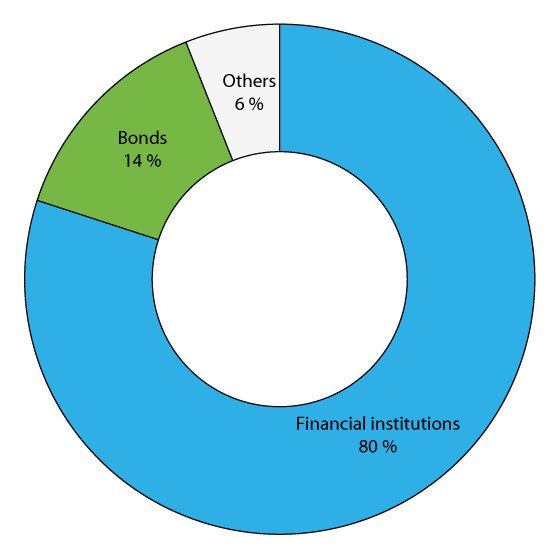
Figure 2.14 Domestic corporate debt by credit source
Source Statistics Norway and Finanstilsynet
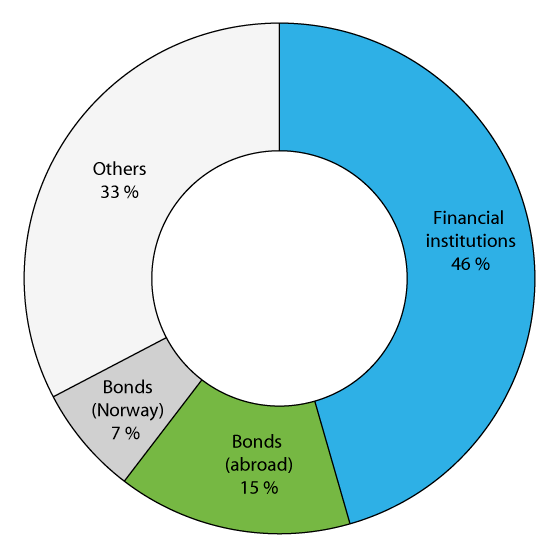
Figure 2.15 Total corporate debt by credit source
Source Statistics Norway and Finanstilsynet
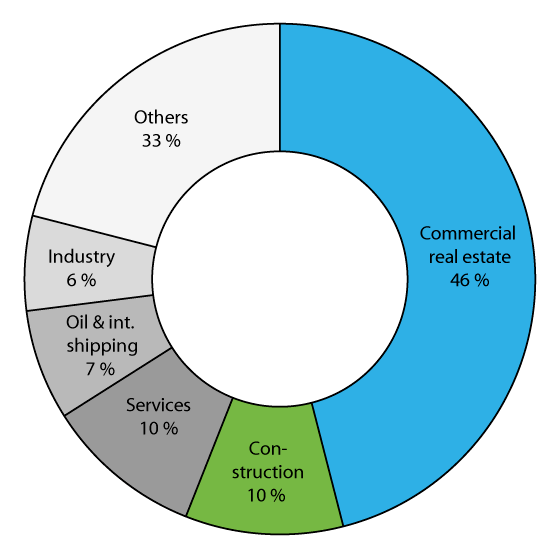
Figure 2.16 Lending by banks and mortgage companies by industry1, as of June 2015
1 The figures exclude loans to companies registered abroad.
Source Statistics Norway and Finanstilsynet
Loans to commercial real estate companies amount to approximately 46 percent of Norwegian-owned banks and mortgage companies’ outstanding corporate loans. A further 10 percent of loans are linked to the construction and building industry. Changes in real estate prices are therefore a substantial risk factor for Norwegian banks. Real prices for commercial real estate rose in 2015, but are sensitive to rental market developments and investors’ required rates of return, and have historically fluctuated significantly in line with general economic trends. Economic downturns quickly lead to a reduction in commercial real estate rents and vacant premises, and thus lower prices and property values. The activity level in the commercial real estate market increased considerably in 2014, and continued to rise throughout 2015. The higher activity is due to several factors, including low financing costs and broader demand due to the weakened krone making Norwegian commercial real estate more attractive to foreign investors.
Corporate profitability and liquidity are important for debt-servicing capacity. The capacity of companies to service debt (cash revenues as a percentage of interest-bearing debt) improved in the early 2000s, but declined in the period leading up to the financial crisis. Since the crisis, corporate debt-servicing capacity has stabilised at a lower level. Debt-servicing capacity varies from industry to industry, and may change quickly if demand for an industry’s products changes. For example, falling oil prices and the drop in oil-investment have contributed to a sharp reduction in the debt-servicing capacity of companies in the oil service industry. High household debt increases the risk of a sudden drop in the debt-servicing capacity of companies in industries which base their activities on demand from Norwegian households.
Debt-servicing capacity is generally lower in the commercial real estate sector than in other industries; see Figure 2.17. Real estate is considered a reliable form of collateral, and property owners thus have easier access to debt financing. Many real estate companies therefore have high interest-bearing debts.
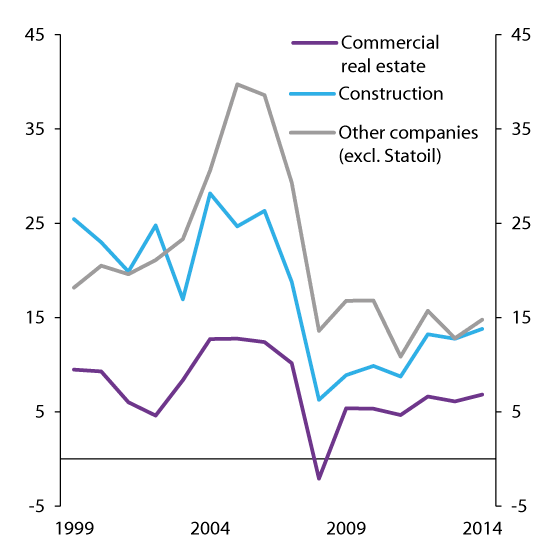
Figure 2.17 Corporate debt-servicing capacity. Defined as cash earnings as a percentage of interest-bearing debt
Source Norges Bank
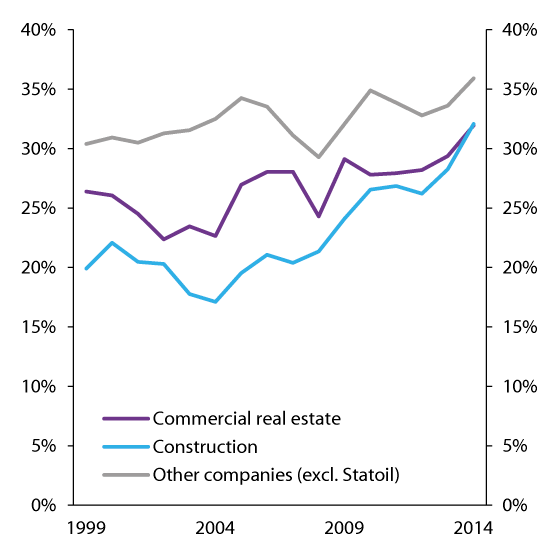
Figure 2.18 Corporate equity ratios. Equity as a percentage of total assets
Source Norges Bank
Corporates’ equity ratio is another important indicator of a company’s ability to absorb economic shocks. A high equity ratio can serve as a buffer during periods when earnings are weaker. Robust companies may also find it easier to get credit when economic uncertainty is high. Corporate equity ratios have risen since the financial crisis. Companies in the construction and building and commercial real estate sectors have typically had lower equity ratios than other companies. These sectors have experienced particularly strong equity ratio growth; see Figure 2.18. However, corporate equity in these sectors is sensitive to falling real estate prices.
2.3.4 Bank financing and liquidity
One of the most important banking functions in any economy is the conversion of short-term deposits into long-term loans to customers. In such maturity transformation, banks assume funding risks. Banks are primarily financed by customer deposits and borrowing from the money and securities markets (wholesale funding). Customer deposits have proven to be a relatively stable source of financing, even during periods of market unrest. This is partly due to the deposit guarantee scheme. Nonetheless, the financial crisis has shown that banks’ access to wholesale funding can worsen when markets are turbulent.
Wholesale funding for banks consists of bonds and shorter-term borrowing in the form of certificates, as well as covered bonds issued by mortgage companies. Mortgage companies are often members of banking groups. Wholesale funding allows banks to manage their liquidity risk in a way which deposits do not permit. However, if banks operate on the assumption that new financing will always be available in the market on short notice, their liquidity risk may increase rapidly and substantially if relevant markets become less liquid.
Approximately 40 percent of the total financing of Norwegian banks and mortgage companies comprises customer deposits; see Figure 2.19. The proportion of short-term wholesale funding has declined in recent years, while long-term wholesale funding (covered bonds and other bonds with maturities exceeding one year) accounts for an increasing share of total financing. At the end of 2015, covered bonds constituted 43 percent of wholesale funding, an increase of one percentage point compared to the previous year. One reason why covered bonds have become a leading source of financing is that banks have profited from transferring residential mortgages with good collateral from their balance sheets to mortgage companies which can issue covered bonds. Around 60 percent of the wholesale funding of banks and mortgage companies is denominated in a foreign currency. Short-term foreign debt, i.e. with maturities less than three months, accounted for 20 percent of total wholesale funding at the end of 2015.
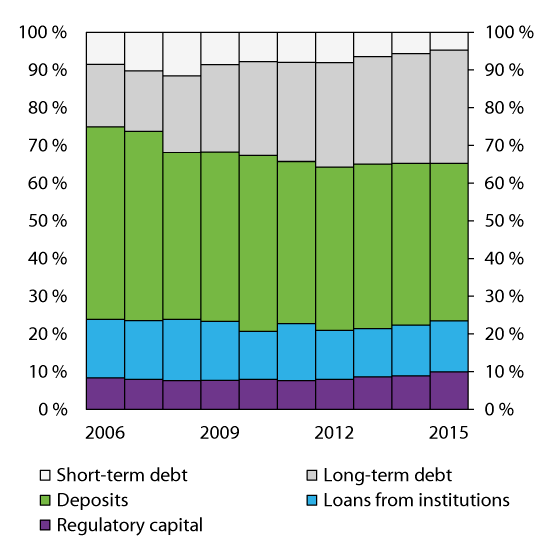
Figure 2.19 Composition of bank and mortgage company financing. Percentage of capital under management
Source Finanstilsynet
Norwegian banks have good access to wholesale funding, although the financial terms on which new financing can be obtained have developed unfavourably recently. Risk premiums on new financing were higher at the beginning of 2016 than the average margins on banks’ outstanding bond financing. If the risk premiums remain at this level, the average margin on banks’ outstanding bank financing will rise somewhat going forward.
Fears of weaker economic growth internationally contributed to increased risk premiums in credit markets in the autumn of 2015 and the first months of 2016. Risk premiums rose for companies across industries and countries. However, in the banking sector, risk premiums increased more than in other sectors, and credit insurance premiums for banks rose sharply in the first weeks of 2016. In the autumn of 2015, the increase in risk premiums was somewhat higher for Norwegian banks with substantial exposure in regions with extensive petroleum-related activity than for other Norwegian banks.
Management of liquidity risk is important for banks. During the financial crisis, many banks and other financial institutions experienced liquidity problems because they had become too dependent on short-term wholesale funding, which subsequently dried up when the crisis began. As access to new financing dropped, many banks rapidly and simultaneously experienced serious liquidity problems. Pursuant to new EU rules, new requirements have been introduced which limit permitted liquidity risk; see Box 2.9.
Textbox 2.9 New liquidity coverage requirement
At the end of 2015, Norwegian banks and banking groups had a total liquidity reserve of 132 percent. The liquidity reserve is measured as liquid holdings as a percentage of net liquidity outflows during a given stress period of 30 calendar days. In other words, a high liquidity reserve indicates that banks and other credit institutions are well equipped to absorb a certain amount of stress. The reserves of larger banks totalled 133 percent, while medium-sized and smaller banks had reserves of 119 percent and 129 percent, respectively; see Figure 2.20. The liquidity reserve can be measured separately for individual currencies, or cumulatively for currencies. The Norwegian krone-denominated liquidity reserve of Norwegian banks totalled 66 percent at year-end 2015.
In accordance with regulatory provisions adopted by the Ministry of Finance in November 2015, systemically important banks in Norway (DNB, Nordea and Kommunalbanken) are required to meet a minimum liquidity coverage requirement of 100 percent as from 31 December 2015. A corresponding requirement for other banks will be phased in over a period of two years.1
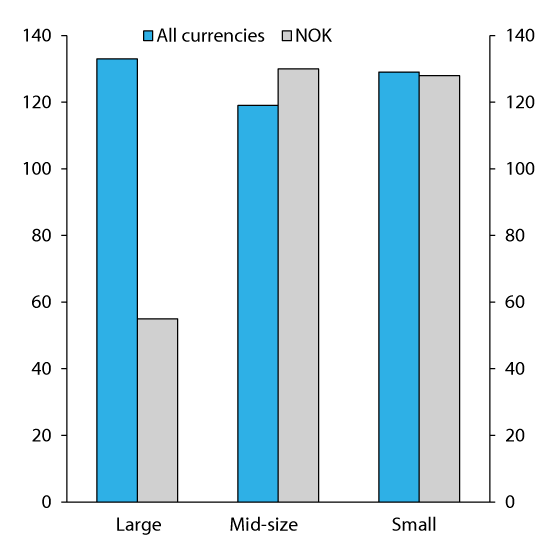
Figure 2.20 Liquidity reserve (liquidity coverage ratio) of Norwegian banks at the end of 2015. Percent
Source Finanstilsynet
1 The requirement is 70 percent from 31 December 2015, 80 percent from 31 December 2016 and 100 percent from 31 December 2017.
2.3.5 Insurance and pensions
Problems experienced by insurance companies and pension funds do not normally represent a direct threat to financial stability. Traditional insurance activity generates little systemic risk, but potential problems in life insurance companies and pension funds may impact financial stability indirectly, including through such companies’ investments in debt securities issued by banks, such as covered bonds. Any uncertainty relating to large life insurance companies may also spread to other financial institutions and affect confidence in these, as illustrated by experiences from the financial crisis. The authorities have therefore introduced rules to promote solvency among insurance companies and pension funds. Furthermore, solvent pension institutions are a prerequisite for secure and predictable pension saving by individual customers.
Textbox 2.10 Stress testing of pension funds
Modelling different crisis scenarios allows central banks, supervisory authorities and others to improve their insight into how well banks, insurance companies and pension funds are equipped to deal with potential periods of weaker economic growth and financial instability.
In 2015, the European Insurance and Occupational Pensions Authority (EIOPA) stress-tested pension institutions subject to the Institutions for Occupational Retirement Provision Directive. The participating pension funds had a market share of over 50 percent (measured by capital under management) in the countries covered by the test. During the test, assets were stressed in two different scenarios featuring share and real estate price falls as well as changes in the interest rate and foreign exchange markets. Liabilities were stressed in a separate scenario featuring rising life expectancy due to a 20 percent drop in the mortality rate.
Pension institutions from 17 countries were stressed in the test, which was the first of its kind. Finanstilsynet was responsible for the conduct of the stress tests in Norway. The seven largest pension funds, which account for almost 60 percent of total capital under management in Norwegian pension funds, participated in the part of the stress test covering defined-benefit occupational pensions.
The results of the stress tests were published on 26 January 2016. The results show that there are substantial shortfalls in many European pension funds, even before these are subjected to negative shocks. Norwegian pension funds performed relatively well during stress testing compared to funds in most other countries. Norwegian authorities have long given high priority to applying identical solvency rules to parties which assume identical risk, including through identical regulation of pension funds and life insurance companies.
Life insurance companies and pension funds promise insured persons a benefit if a defined event occurs, for example if the insured person becomes disabled or reaches retirement age. The monetary value of these commitments constitutes the most important liability of life insurance providers and pension funds. The risk borne by such companies is linked to the types of insurance policies held by customers and how contracts are designed.
Interest rates have fallen in recent decades, and are at present at historical lows. Life insurance companies and pension funds have gradually reoriented their business models during this period, transferring risk to insured persons in exchange for greater personal influence over how pension assets are managed. This applies particularly to market risk, where the sale of products in which the insurance providers bear risk has ceased almost completely. The authorities facilitated the development of markets for new products with different risk properties when they granted defined-contribution pension schemes the same preferential tax treatment as guaranteed (defined-benefit) pension products in the year 2000.
However, life insurance policies are generally long-term agreements, and contracts specifying an annual guaranteed rate continue to make up a material proportion of the liabilities of Norwegian pension institutions. The low international interest rate level is a challenge for providers with a high proportion of guaranteed products. The average guaranteed rate among life insurance providers was just over 3.1 percent at the end of 2015; see Figure 2.21. The market rate on most government bonds is now lower than the average guaranteed rate, and continuing low interest rates may make it difficult to achieve a return exceeding the guaranteed rate. Providers currently hold many bonds purchased when the interest rate level was higher, and when these mature they will have to be replaced by new bonds carrying lower interest rates.
Subject to certain exceptions, for example paid-up policies, companies can charge a guaranteed rate premium for pension products offering a guaranteed rate. Life insurance companies have in recent years collected approximately NOK 1 billion in annual guarantee rate premiums from private-sector enterprises, as well as a corresponding amount from the municipal sector. This does not include guaranteed rate premiums collected by pension funds. The ability to change the premium from year to year allows the premium to be adjusted in line with developments in return prospects.
Companies’ interest risk can also be reduced by lowering guaranteed rates. To limit risk-taking by companies, the authorities have long capped the guaranteed rate companies are permitted to offer customers. Companies have always had discretion to decide whether to offer the maximum guaranteed rate permitted or a lower one. In view of low interest rates and weak return prospects, Finanstilsynet reduced the maximum guaranteed rate from 2.5 percent to 2.0 percent as of 1 January 2015; see Figure 2.21. The decision only affects the guaranteed rate for subsequent pension accruals. Accordingly, if companies have already concluded contracts and received premiums relating to pension accruals subject to a higher guaranteed rate, the higher guarantee will continue to apply to the insured person.
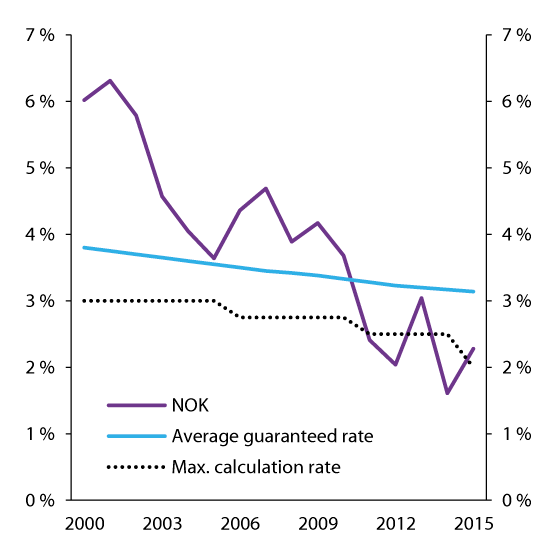
Figure 2.21 Development of average guaranteed rate among Norwegian life insurance companies, long-term interest rates (10-year government bonds) and maximum calculation rate
Source Finanstilsynet
A lower guaranteed rate means that premium payments for a given benefit must be increased. Together with the increased guaranteed rate premium for previous accruals, this makes schemes offering agreed benefits more expensive for employers to finance when interest rates fall. Many private-sector enterprises have shifted to defined-contribution schemes in recent years; see Figure 2.22. Defined-contribution schemes do not offer a fixed level of future payments. Instead, these depend on the return achieved during the accruals period. Switching from defined-benefit schemes to defined-contribution schemes shifts risk away from employers and insurance companies. Instead the insured persons carry risk by increasing their exposure to the securities markets. As stated above, in return the insured persons usually gain greater influence over the management of their pension assets.
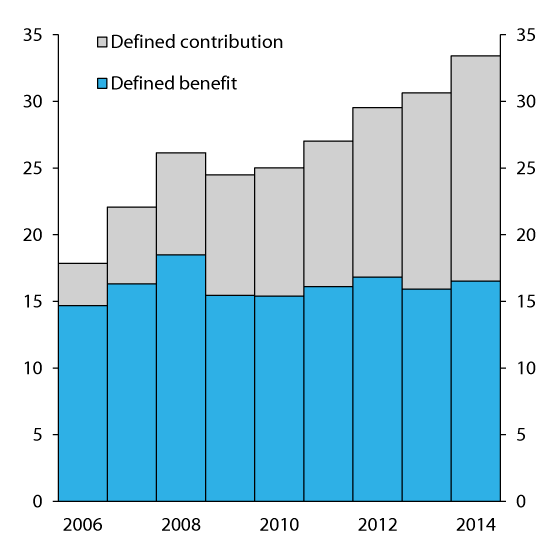
Figure 2.22 Gross payable premiums in defined-benefit and defined-contribution pension schemes in Norwegian life insurance companies. NOK billion
Source Finance Norway
Textbox 2.11 Capital requirements in the Solvency II framework
To calculate solvency capital under the Solvency II framework, liabilities and assets are to be valued at the amount for which they can be traded in a transaction at arm’s length between well-informed parties (“fair value” or “market value”). In the absence of market prices, the value of insurance liabilities must be set as the expected value of future cash flows linked to each individual insurance liability, discounted using risk-free market rates and based on a probability assessment of different levels of future cash inflows and outflows. Finally, a risk margin must be added.1
Solvency II contains two new capital requirements: the solvency capital requirement (SCR) and the minimum capital requirement (MCR).
The solvency capital requirement is designed to take into account all types of quantifiable risk, and to cover unanticipated losses in existing operations as well as losses which may arise in operations established in the next 12 months. Account must be taken of the effect of risk-reduction measures, diversification and correlation between different risks. Solvency capital must total at least an amount that is 99.5 percent likely to exceed the undertaking’s total losses over a period of 12 months, calculated in accordance with a standard method or using internal models. The minimum capital requirement must be calculated as a linear function of insurance-related provisions, written premiums, capital-at-risk, deferred tax and administrative expenses. The minimum capital must total at least an amount that is 85 percent likely to exceed the undertaking’s total losses over a period of 12 months, and may not be lower than 25 percent or higher than 45 percent of the solvency capital requirement.
1 The risk margin is intended to ensure that the valuation is not excessively low, and must be set as an amount corresponding to the cost of holding capital to meet the solvency capital requirement linked to the liabilities in question over the lifetime of these liabilities.
However, for insurance companies an undertaking’s shift from a defined-benefit pension scheme to a defined-contribution pension scheme often means the conversion of assets saved through the old scheme into paid-up policies. Paid-up policies are fully paid insurance policies which confer entitlement to a future pension without the employer having to make further premium payments. The winding-up of defined-benefit schemes has increased the volume of paid-up policies, which now account for around 20 percent of life insurance company liabilities. In the municipal sector, defined-benefit schemes may not be converted into defined-contribution schemes, and thus no paid-up policies are issued.
Insurance companies are not permitted to charge a guaranteed rate premium for paid-up policies or individual insurance policies established before 2008. Instead, companies are entitled to a share of any excess return from asset management. An excess return exists if the return is higher than the guaranteed rate. This makes life insurance companies and pension funds vulnerable if they have accumulated inadequate net asset buffers before a period of low returns.
Textbox 2.12 Building reserves to address rising life expectancy
Life expectancy in Norway is rising. In 2013, Finanstilsynet introduced a new minimum requirement for the so-called mortality table (K2013) to help life insurance companies and pension funds allocate sufficient capital to address increased life expectancy. The switch to the new mortality table requires insurance companies to raise premiums for retirement pensions in collective pension schemes. Financial provisions in respect of already accrued retirement pensions also have to be increased. Life insurance providers have been given up to seven years from 2014 to implement such reserve building. Providers may use any profits from their management of customer assets – which should in principle be credited to customers – to fund up to 80 percent of reserve building. Such profits are equal to the return on the collective portfolio exceeding the interest rate the company has guaranteed to customers. The providers themselves must provide at least 20 percent of the reserves.
Providers have built up most of their required reserves over the past three years. Life insurance providers built up reserves in respect of increased life expectancy of approximately NOK 7.4 billion in 2015, leaving an outstanding reserve building need of just under NOK 6 billion at year-end. In total, pension funds allocated around NOK 10.5 billion to reserve building by the end of 2015. The majority of pension funds are fully provisioned, and Finanstilsynet’s stress tests as of Q4 2015 showed that the funds have a remaining reserve building need of just under NOK 500 million.
New statutory and regulatory provisions effective as of September 2014 allow insurance companies and paid-up policy holders to conclude voluntary agreements to convert paid-up policies into paid-up policies with investment choices. With such voluntary conversion into a new contract, the paid-up policy holder surrenders the guaranteed rate and is therefore no longer entitled to a specified annual benefit upon reaching retirement age. In return, the holder of the paid-up policy can decide how capital is to be managed, and keeps all returns. Currently, most paid-up policy holders have a guaranteed rate which far exceeds what can be achieved through low-risk investments in the market. For many holders of paid-up policies it is therefore in principle most profitable to keep the paid-up policy and instead adjust the remaining portfolio, for example to assume more risk to achieve a higher expected return. The positive value of the guaranteed rate to customers is accompanied by a corresponding negative value for companies. This may give companies excessive incentives to conclude agreements on investment choices. Consequently the authorities have introduced strict statutory requirements relating to the advice companies give to customers.
Due to rising life expectancy, life insurance companies and pension funds have to set aside more capital to cover their pension liabilities. Such reserve building has largely been completed; see Box 2.12. The Ministry of Finance has introduced a requirement that paid-up policies must be fully provisioned before they are converted into paid-up policies with investment choices.
Textbox 2.13 Profits and profitability among insurance companies and pension funds
Life insurance companies generated pre-tax profits of NOK 8.2 billion in 2015, an increase of NOK 2.3 billion on 2014. The value-adjusted pre-tax profits, which include unrealised capital gains, totalled NOK 9.8 billion, significantly less than the 2014 figure of NOK 20.2 billion. The decline is due to factors including weaker stock market growth in 2015 than in 2014.
The pre-tax profits of pension funds were NOK 3.1 billion in 2015, up from NOK 1.9 billion in 2015.1 The fluctuation reserves grew by less in 2015 than in 2014, amplifying the drop in value-adjusted profits from NOK 6.6 billion in 2014 to NOK 4 billion in 2015.
Non-life insurance companies achieved pre-tax profits of NOK 7.8 billion in 2015 – a drop of NOK 2.3 billion compared to the previous year. The decline is primarily due to a fall in financial income of more than 50 percent.
The combined ratio of non-life insurance companies – measured as incurred losses and expenses over earned premium – was 86.2 percent in 2015; see Figure 2.23. This was one percentage point higher than the previous year. A combined ratio in excess of 100 percent means that the company needs other income than premium income to break even; for example financial income. The claims ratio, i.e. claim payments as a percentage of premium income, increased by around 0.6 percentage points from 2014, to 68.9 percent in 2015. The cost ratio, i.e. operating expenses as a percentage of premium income, rose by 0.4 percentage points in 2015, to 17.3 percent.
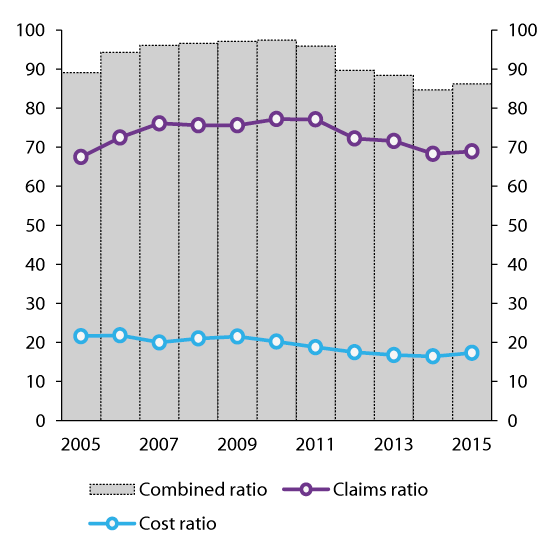
Figure 2.23 Developments in the combined, claims and cost ratios of Norwegian non-life insurance companies. Percent
Source Finanstilsynet
1 The figures relate to the 48 largest pension funds in Norway, which represent around 95 percent of total capital under management by pension funds.
Using different buffer fund mechanisms, life insurance companies can smooth return and risk results over several years. The use of such buffer funds allows companies to use strong results in certain years to make up for weaker returns in others. The size of these buffer funds is an indicator of the companies’ ability to absorb weak returns and higher risk in the future. At the end of 2015, the buffer funds of life insurance companies totalled NOK 82 billion, equivalent to 9.4 percent of insurance liabilities.
All life insurance companies met the capital adequacy requirement of 8 percent at year-end 2015. On 1 January 2016, the capital adequacy requirement was replaced by the solvency capital requirement and the minimum capital requirement in the Solvency II framework. The new Solvency II capital requirements are designed to reflect the risks assumed by companies better than the former requirements; see Box 2.11. In the period 2008–2015, insurance companies have reported stress test results based on a simplified variant of the solvency capital requirement in Solvency II. The stress tests provide information on the size of so-called loss potential relative to a company’s loss-absorption capital (buffer capital). If this ratio – referred to as buffer capital utilisation – is 100 percent or lower, the company can be said to be compliant with a simplified variant of the solvency capital requirement in Solvency II. At the end of 2015, average buffer capital utilisation was 116 percent among life insurance companies as a whole. However, if account is taken of a key transitional provision in the Solvency II framework (stating that any increase in the value of insurance liabilities due to a change to a new valuation under the Solvency II rules can be phased in over a period of 16 years), the estimated average buffer capital utilisation was 75 percent.
2.3.6 The securities markets
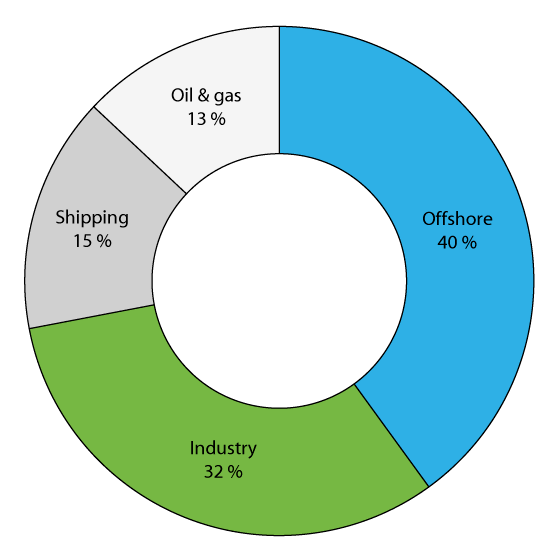
Figure 2.24 Outstanding volume of high-yield bonds, by sector at the end of 2015
Source Finanstilsynet
Oslo Stock Exchange is a small financial marketplace in global terms. The stock exchange and other marketplaces facilitate matching of the capital needs of businesses with the investment needs of capital owners. Information and transparency in the marketplace allow professional parties to evaluate risk and where capital can achieve the highest returns.
The Norwegian State owns a relatively large proportion of the securities listed on Oslo Stock Exchange. Around 66 percent of the assets on the exchange are privately held, with international owners accounting for approximately 37 percent of private sector holdings. The Norwegian market for high-yield bonds, i.e. bonds issued by companies with weaker credit ratings, is an example of a sub-market with a considerable proportion of international investors. Oslo Stock Exchange is the largest Nordic market for such securities. It is an internationally important marketplace for industries such as seafood, energy, oil service and shipping. Energy-sector companies accounts for approximately 27 percent assets listed on Oslo Stock Exchange, which is home to the greatest number of energy-related companies of any exchange in Europe. Oil service has become a key energy-sector segment in recent years. Measured by number of listed companies, Oslo Stock Exchange is the second-largest oil-service exchange in the world. It is also the world’s second-largest financial shipping marketplace, and the world’s largest marketplace for seafood companies.
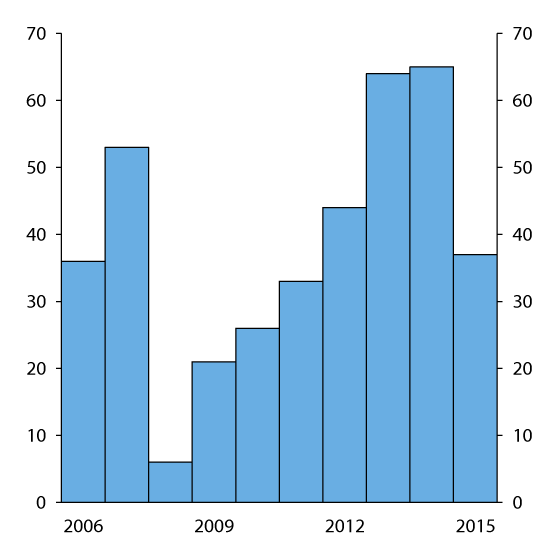
Figure 2.25 High-yield bonds issued in the Norwegian market. NOK billion
Source Stamdata
The Norwegian market for high-yield bonds attracts substantial interest from international investors. Norway’s strong position in industries like oil, shipping and seafood explains some of the growth in this market, in addition to simpler legal requirements than elsewhere in Europe and the US. It is difficult to estimate the market’s size, since there are no mandatory reporting requirements. Moreover, as issuers are not credit-rated, the availability of market data depends on a range of assumptions relating to the relevant part of the market.
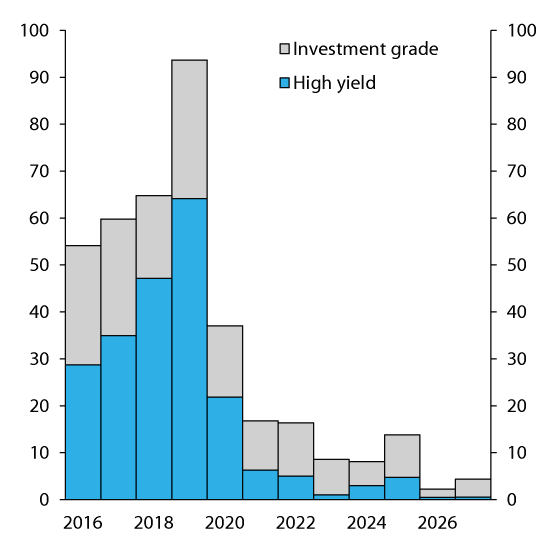
Figure 2.26 Maturity structure of corporate bonds in NOK billion
Source Stamdata
Textbox 2.14 Mutual funds
Mutual funds are a collective investment where many savers (unit holders) jointly invest their funds in the securities market. Management is undertaken by a fund management company based on a defined mandate which specifies the markets and segments in which capital is to be invested, and how. The most common fund types in Norway are equity funds, money market funds, bond funds and combination funds. At the end of 2015, Norwegian-registered mutual funds had NOK 904 billion in capital under management. Net new subscriptions in 2015 show that demand for equity funds has fallen considerably in favour of combination funds and money market/bond funds.1 Net equity-fund redemptions totalled NOK 24 billion in 2015, while net subscriptions amounted to NOK 4.5 billion and NOK 30 billion, respectively, for combination funds and money market and bond funds.
1 Combination funds invest in both shares and the interest rate market, but are not permitted to invest more than 80 percent of their assets in shares. Bond funds invest in different debt securities. Money market funds are interest rate funds which invest in short-term interest-bearing securities, i.e. certificates and bonds.
Figure 2.25 provides an overview of the volume of high-yield bonds issued in the Norwegian high-yield bond market from 2006 to present day. In 2015, the high-yield bonds issued in the Norwegian bond market totalled approximately NOK 37.5 billion, a decrease of more than NOK 27 billion compared to 2014. Figure 2.24 shows that, measured by outstanding volume, 40 percent of the high-yield bonds are related to offshore service, 32 percent to manufacturing and 15 percent to shipping. These are sectors which have historically been affected by fluctuations in oil prices. In the years ahead, there will be a considerable need for refinancing in the high-yield bond market; see Figure 2.26. It is uncertain how the market will meet this need going forward.
2.4 Operational risk in financial institutions
Operational risk is the risk of loss as the result of incomplete or inadequate internal processes, systems failure or human error. Operational risk includes legal risk and reputational risk. The causes may, for example, be inadequate procedures, defective information and communications technology systems (IT systems), regulatory violations, fire, attacks and breaches of duty by employees. Delimitation against other types of risk is not precise, and losses classified under credit risk or market risk may be caused or exacerbated by operational vulnerability, for example weaknesses in credit evaluation processes.
Textbox 2.15 Investment firms
Investment firms arrange the buying and selling of financial instruments and provide investment advice in connection with such transactions. They also advise companies and facilitate mergers and acquisitions. Investment firms analyse and advise on the risk and return prospects of investment projects. Over the past 15 years, the most important revenue sources for investment firms have been corporate finance activities and the brokering of equity instruments. Figure 2.27 illustrates the relative development of these two revenue sources among investment firms that are not integrated into banks. During this period, corporate finance activities have become far more important than the revenues generated by brokering equity instruments.
Investment firms that are not integrated into banks registered operating income of NOK 5.85 billion in 2015, approximately NOK 0.6 billion less than in 2014. Total operating profits were just under NOK 1 billion, NOK 446 million less than in the previous year. The main reason for the decline is structural changes in the industry following the entry into force of the AIF Act – a new act relating to the management of alternative investment funds (AIFs) – and the fact that a number of investment firms have thus become AIF managers.
Investment firms that are integrated into banks generated total revenues from investment services of around NOK 7.1 billion in 2015, approximately NOK 200 million more than in the previous year. This equates to an increase of 3 percent from 2014 to 2015.
Norwegian branches of foreign investment firms achieved revenues of NOK 2.5 billion in 2015, approximately 3 percent more than in the preceding year.
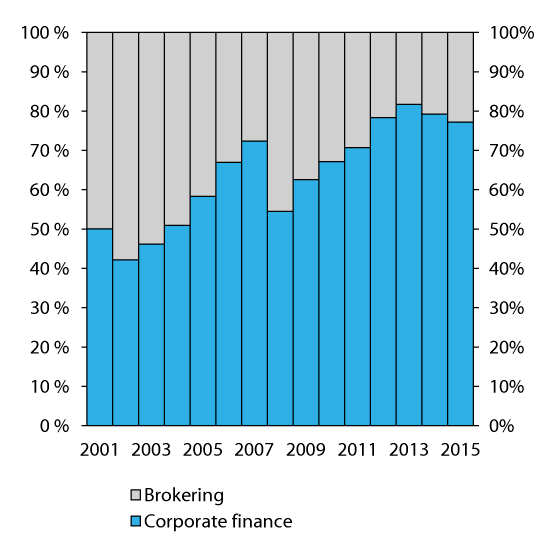
Figure 2.27 Relative development of the two traditionally most important revenue sources of investment firms not integrated into banks, 2001–2015
Source Finanstilsynet
Important instruments for reducing operational risk include identification of vulnerabilities and subsequent preventive efforts to make financial institutions and financial markets less vulnerable and ensure adequate preparedness for dealing with risk events. Although much of this work must be done at the individual company level, there is also a need for a strategic overview and coordinated measures. The Financial Infrastructure Crisis Preparedness Committee (BFI) is mandated to promote coordination of financial infrastructure preparedness efforts. The Committee evaluates operational stability, risk and vulnerability in the financial infrastructure, and can be convened in the event of a serious incident. In 2015, the Committee held three regular meetings and conducted one emergency preparedness exercise.
Systemic stability in the Norwegian financial infrastructure is good, and losses as the result of misuse and fraud are small. The infrastructure is nonetheless vulnerable to technical failure and external threats. Figure 2.28 shows that there were generally fewer problems with financial infrastructure systems in 2015 than in 2014 and previous years. This improvement was achieved despite several financial institutions changing their operational locations and suppliers in 2015, which entailed some risk of problems and disruptions. Attacks and other adverse events relating to financial infrastructure have only resulted in small direct losses thus far. Much of the reason for this lies in the measures and precautions taken by individual companies, as well as the joint efforts of the stakeholders.
New technology has rationalized financial service provision and enabled the financial industry to offer new services. In recent years, many new internet-based and mobile solutions and products have been introduced in the area of payment services. New technology, new services and outsourcing of IT systems operation and development may give rise to new, previously unknown, vulnerabilities and challenges for those tasked with evaluating and monitoring operational risk in the financial system. Until around the year 2000, the IT operations of all Norwegian banks were located in Norway. Today, a majority of the IT operations of Norwegian banks and branches have been relocated abroad. Outsourcing of IT operations may alter the quality and stability of systems and weaken oversight and control of vulnerabilities in systems which underpin companies’ operations. It is important that IT tasks are outsourced responsibly, bearing in mind the situations of both the individual financial institution and the financial system as a whole. Accordingly, in 2014 the Government proposed new statutory rules defining what kinds of tasks financial institutions may outsource as well as laying down rules granting Finanstilsynet power to monitor outsourcing and implement measures to address irresponsible outsourcing. The rules were adopted by the Storting on 20 June 2014, and entered into force on 1 July 2014.
Norges Bank and Finanstilsynet publish annual reports on financial infrastructure. Norges Bank’s Annual Financial Infrastructure Report reviews developments in the areas of retail payment services and interbank systems, while Finanstilsynet’s Risk and Vulnerability Analysis examines the use of information and communications technology in the financial sector.
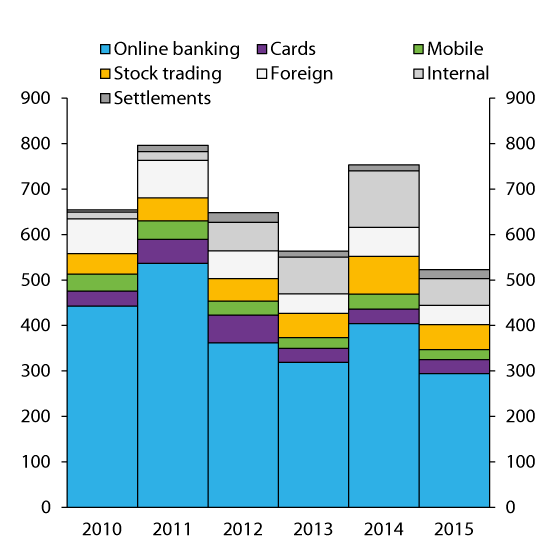
Figure 2.28 Impact-weighted adverse events and errors in Norwegian financial institutions1
1 The data in the figure are taken from mandatory reports on adverse events and errors to Finanstilsynet. Finanstilsynet has developed a database of information about such events which it uses in its supervisory activities. Thus far, few international statistics are available for use in comparing the quality and availability of the Norwegian systems with other countries’ systems. The reports received by Finanstilsynet only provide information on developments from year to year in Norway. The values along the vertical axis express a weighted cumulative appraisal of the scale of damage caused by events affecting certain services. These services are online banking (private and corporate), payment cards, mobile payments, securities trading, cross-border payments, internal services and settlement. The scale of damage is derived from the number of users affected, the duration of each event and a discretionary assessment of the impact of the event on users.
Source Finanstilsynet
Footnotes
Calculations show that petroleum industry demand amounts to between 12 and 17 percent of mainland Norway GDP. Source: Finanstilsynet, Financial Trends 2015.
In the case of banks with no estimated exposures to companies indirectly affected by lower oil prices, Finanstilsynet estimates that lower oil prices will have an indirect negative impact on around 3.5 percent of the corporate loan portfolios of these banks.
Finanstilsynet, Financial Trends 2015.
The International Monetary Fund (IMF) regularly conducts thorough reviews of the financial systems of its member countries under its Financial Sector Assessment Program (FSAP). Norway was the subject of a review from the summer of 2014 to the summer of 2015; see Box 4.3.
BIS Annual Report 2015.